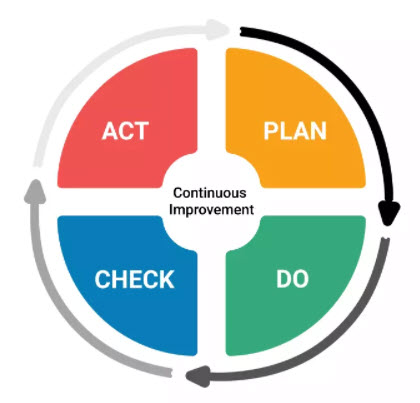How ISO 45001 can improve the safety of your workplace
According to the Australian Bureau of Statistics Work-Related Injuries Survey, more than 560,000 people had a work-related injury or disease in the 2017–18 financial year.
From a global perspective, a worker dies from a work-related accident and 153 workers experience a work-related injury every 15 seconds.
These numbers have a devastating impact on businesses and society as a whole — but with effective processes in place, these incidents can be prevented.
ISO 45001 (occupational health and safety management) helps organisations of all sizes and industries to develop a safer working environment for all employees. The aim of the standard is to reduce workplace injuries, deaths and diseases through robust safety management systems and processes.
Here, we share three examples of how this standard can improve the safety of your workplace — but first, let’s take a closer look at ISO 45001.
Why should my business be ISO 45001 certified?
Work-related accidents are a traumatic experience for the victim and your team as a whole. But from a business perspective, there is also a huge range of other consequences to contend with.
The direct and indirect costs of work-related accidents and illnesses sit at around $3.8 trillion AUD worldwide. Former Chair of Project Committee ISO/PC 283 Occupational Health and Safety Management Systems, David Smith, had this to say on the matter:
“Apart from the devastating impact on people, poor OHS management can have many negative effects on organisations such as the loss of key employees, business interruption, claims, insurance premiums, regulatory action, reputational damage, loss of investors and, ultimately, the loss of business,” David says.
“Businesses need to ensure they manage all their risks to survive and to thrive. OHS is a key aspect, which every business has to manage proactively.”
ISO 45001 offers a simple Plan-Do-Check-Act model to help organisations plan what needs to happen to minimise the risk of harm on and offsite. Your OHS system should address concerns that lead to long-term health issues and absence from work as well as those that cause accidents.

Image: Kanbanize
We covered the Plan-Do-Check-Act model in a recent article. Essentially, this model allows you to quickly and easily review your OHS management system, monitor its effectiveness, identify potential gaps in the system and provide new opportunities for improvement.
Regular audits using the Plan-Do-Act-Check model can help reduce work-related incidents both on and off-site. This can have a positive impact on workplace safety, productivity, team morale and more.
3 ways ISO 45001 can improve safety in the workplace
#1. You will proactively identify and address hazards in the workplace


Image:
Through the Plan-Do-Check-Act model, you will be able to identify potential hazards in the workplace and create firm processes to minimise the risk of injuries, illnesses and deaths on or offsite.
The ISO45001 standard takes a risk-based approach to workplace health and safety i.e. you can identify and address potential risks before accidents even happen.
This process, in itself, offers a wide range of benefits for your business:
- A sense of trust between employer and employees
- A safer, happier workplace
- A positive reputation with third parties (increasing potential tender prospects)
- A lower insurance premiums
- A reduced employee turnover.
Think of the Plan-Do-Check-Act framework as your “early warning system” for potential risks, so you can prevent accidents rather than react to them.
#2. You will minimise risks with continual analysis and improvements


Image: Pexels
Identification of OHS risks and opportunities is the first step in the process. The next step is to analyse the associated impacts to identify and take appropriate actions to minimise risks, eliminate hazards or correct gaps in the system.
ISO 45001, like all ISO standards, is about continual analysis and improvement. Addressing the “check” and “act” stages of the Plan-Do-Check-Act model can further minimise risks and make your workplace a safer, more efficient space.
Here are some potential questions you and your team can cover off during the review or analysis stage:
- Have there been any unexpected challenges within the business recently?
- Have any of our team members reported challenges or accidents on or offsite?
- Have we been using any new machinery that could be hazardous?
- Are our team members trained well enough to use this machinery safely?
- Have we been working on any new or challenging sites recently?
Consider reviewing your OHS system and processes quarterly, bi-annually or annually. This will help keep on top of process improvements and workplace safety.
#3. Your employees will have set processes on how to reduce the risk of injuries and illnesses


Image: Pexels
As your OHS system and processes improve, your team members will require additional training to get up to speed. This training will not only improve your team’s skill set, but their new and improved knowledge will allow them to work safer on and offsite.
Thanks to improved processes and training, your team members will feel more confident in their individual roles, be more mindful of best practices and take responsibility for their own safety (as well as the safety of their coworkers).
How QMS can assist with ISO 45001 certification
In order to achieve ISO 45001 certification, you need to prove compliance to the requirements of the Standard. You will be required to pass an assessment and implement any necessary improvements to improve safety in the workplace.
Our industry-experienced assessors can perform certification assessments against the ISO 45001 Standard, so you can continually improve your business, undertake the process of certification and become formally certified.
At QMS, we are one of Australia’s leading accredited certification bodies
For more information about ISO 45001, contact QMS today.
Image: Pexels

